Cultural Substratum
When researching, the influence of the cultural substrate was not specifically studied. However, certain similarities in the culture of ethnic groups that populated the same areas were discovered. For example, we concluded that the Urheimat of the ancient Greeks was in the area, which later was occupied by the Norsemen, and then the ancestors of Ukrainians. The Greek language substrate supports this conclusion. However, the confirmation can be found also in the comparison of the ethnography of the ancient Greeks and Ukrainians.

The Greek dance Crane from a vase in the Museo Borbonico, Naples.
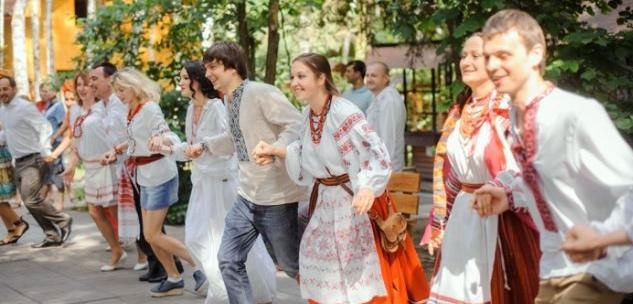
At left: he Ukrainian dance Crane
For example, both the Greeks and the Ukrainians have wedding folk dances under the same name "Crane". Judging by the descriptions in the specialized literature, the dances are very similar (see the article by Anatoly Bogorod on the website "Traditional dances Ukraine"). If this dance is still known in Scandinavia, then it can be considered a cultural substratum
You can also specify different Greek-Ukrainian cultural parallels having similarities also in other East Slavic peoples. The Ukrainian words korovod, khorovod (Rus khorovod, Br karagod , etc.) have matches in Gr χορεια "dance" and χοροσ "choir". Slavic words have no satisfactory etymology, so it is likely that they are the ancient Greek culture substrate, as they have similar dances. Greek culture substrate, but very mysterious, may also be Ukrainian games with a stick, having similar names skoperdin and shkopirta, what is to throw a curved stick in such a way that it hits the ground alternately both ends. Max Vasmer corresponded to these words Gr. Σκαπερδα "game of boys while Dionysia", but later decided against it, because he believed that the words could be taken from Modern Greek, but such words are absent there (VASMER MAX, 1971, 649-50). However, the mystery lies in others. The Greek game, albeit with a stick, is significantly different from the Ukrainian one, and the similarity is only in the name. As it turned out, the word skoperdin is well decoded using Icelandic words skoppa "bounce" and jörðin "earth", exactly corresponding to the nature of the game. Thus, we can confidently speak only about the North Germanic substrate in the Ukrainian language.
Observations of archaeologists have also noted the similarity between the funeral tradition of the Slavs of Zarubintsi culture and ancient Greeks:
We do not know, how early Zarubyntsi population called the settlements and cemeteries, but the essence of ancient Greek names (polis – necropolis) is surprisingly precisely shown in Zarubyntsi topography – a settlement was located on one cape, the place for alive, a burial ground was on the next cape, the place for died (MAKSIMOV E.V. 1982: 59).
* * *
Some searches for similarities in the culture of Ukrainians and Chuvash were carried out more or less carefully only to confirm the presence of the Proto-Chuvashes in Ukraine at Pre-Scythian and Scythian times (see the section Genesis of Scythian Culture). Ukraine was inhabited all the time therefore life experience and cultural traditions of the local population were transmitted to newcomers by the principle of superposition even at large-scale migrations. The need to transfer the information was required in many ways by the nature of local geography, the landscape, the availability of raw and building materials, natural dyes, etc. Thus, the folk culture of Ukrainians could absorb and retain to this day some elements of the culture and customs of the previous population, namely of the Teutons, Proto-Chuvashes, and, maybe, Kurds (see the section To the Question of Slavic-Iranian Language Connections). But, apparently, the folk culture of later Germans was being developed more rapidly in close proximity to the various peoples of Central and Western Europe and didn't preserve that archaism which can be found in the cultures of the Ukrainians and Chuvash. Therefore, it is more promising to search for common cultural elements in the folk art of very these people.
Chuvash folk culture is very rich and attracted the attention of researchers in the 18th century. ( G. Miller, I. Lepekhin , a.o.). Since then, Chuvash folk art was the subject of careful research, and its high artistic level was reflected in the fact that the products of Chuvash masters have been exhibited at shows from the end of the 19th century in Russia and in the Soviet era. Over the past two and a half centuries since the beginning of the research, extensive material has been accumulated, and many books have been written on the Chuvash folk culture, but it is difficult to find the necessary data for our topic. During their long history, the Chuvash have experienced the cultural influences of many peoples and their cultural heritage is very diverse and multi-layered.
It seems appropriate that one should first pay attention to the Ukrainian and Chuvash embroidery as Ukrainians and Chuvash differ from neighboring nations by richness and variety of embroideries (see Comparing Folk Dress of Some East European Peopl). Ukrainian embroidery is "one of the oldest and most popular arts and crafts» (PAVLUK S.V. Ed. 2006.) The Chuvash say about themselves: "We left for the world a hundred thousand words, one hundred thousand songs, and one hundred thousand embroideries". The Ukrainians rate their songs and embroidery likewise. Chuvash embroidery art goes back centuries. A fact is known that when the embroidered dress of Khazar Kagan's daughter struck the whole Byzantine court with its luxury:
Craft and art apparently thrived in the country (Khazar Khanate – V.S.), including the art of sewing. When the future Emperor Constantine V married the daughter of Khazar Khan, she brought with her a dowry splendid dress, so struck the Byzantine court that it became a male ceremonial attire there (KOESTLER ARTUR, 2006: 48)
Of course, it was not sewed by the princess herself but by anonymous masters of the common Proto-Chuvahes dwelled in Khazaria. There is the earliest evidence of the widespread art of sewing in the Northern Black Sea. Remains of gold embroidery on silk were found in one tomb of a noble Sarmatian woman in Sokolova Mohyla in the village of Kovalivka (Mykolayiv Region). Embroidery dates back to the 1st century AD and "demonstrates highly professional art, figurative art-committed and technical means of expression" (KARA-VASIL'YEVA TETIANA, 2008: 15).
Human clothing had always been not only utilitarian, but also a sacred character, so the symbolism of embroidery, expressed in traditional ornament, very often has a profound sense that now can not be often explained by masters themselves, it needs special studies, and in particular the study of Chuvash ornament :
Originality, artistic merit, and the high complexity of the Chuvash ornament were noted by researchers more than two hundred years ago, and since then, in the course of such a large amount of time studying it is a problematic matter (TROFIMOV A.A. 1977: 26)
However, the author of these words and other experts still make some generalizations and find typical or characteristic features of national ornaments. If we turn to the literature, it can be concluded that one of the main characters of this (and not only this!) form of folk art of Chuvash and Ukrainians is the Tree of Life, sun signs, and possibly water. The Tree of Life is one of the options of the World tree as a characteristic mythic-poetical image embodying a general concept of the universe and peculiar worldview of many peoples of the world in the early stages of their spiritual development. However, one cannot argue that this image necessarily has common human roots, as could it arise independently in different nations only because of the generality of the basic features of human psychology. World Tree appears in different versions with more or less pronounced features such as the "tree of life", "tree of death", "tree of evil", "tree of good", "tree of knowledge", "tree of fertility", "tree of heaven" etc. Tree of Life as a whole represents the triune complex of mystical birth – fertility – death and reflects a general idea of the gradual development of a variety of carriers of life (people, animals, plants, and some elements of inanimate nature). The wonderful property of life to reproduce itself was an unsolved mystery for man and his imagination endowed mystical properties for individual elements of the surrounding nature. The embodiment of strength, stability, longevity and even immortality was a familiar image of a tree and just this image was taken as a basis for trying to recreate the paintings of the natural development of the whole universe.
The most ancient way of fixing the Tree of Life could be found in Genesis Scripture (TOPOROV V.N., 1991, MFW, Volume 1: 396-406). This image dates back to the Sumerian version of the Epic of Gilgamesh, where you can see the primary features of the world tree. We can assume that the image of the world tree has long been common among the peoples of the Middle East, ie in places not far away from the cradle of humanity whose localization coincides with the sacred as the texts and the results of scientific research. Spreading across the expanses of the earth's surface, people took to the road Protect symbol of the world tree, but different groups according to natural conditions, especially life and social self-organization develop it in many different forms with different mystical functions. There is reason to assume that people of Middle Eastern origin eventually penetrated the Balkans in Eastern Europe. In the IV – III millennium BC agricultural civilization of Trypilla-Cucuteni existed on the territories of Right-bank Ukraine and Romania, whose roots can be traced to Asia Minor and the Near East. Numerous archeological finds give us good imagination of the material culture of its creators. Some elements of Trypillian culture and mythology were borrowed by their left-bank neighbors, the creators of Pit culture, among whom were the Bulgars, the ancestors of the Chuvash:
Another element, borrowing apparently from Trypilliana, can be a Christmas pattern, a kind of image of the "Tree of Life", which is found on the plates of stone boxes or plates that cover the burial, as well as on burial stells of Pit culture (ALEKSEEVA I.L. 1991:22)
As the ancestors of the modern Chuvash, crossing to the right bank of the Dnieper River, came into contact with Trypillians and borrowed from the elements of their economy, culture, and mythology. Some parts of the Proto-Chuvashes remained in Western Ukraine until the arrival of the Slavs in the land, namely the ancestors of modern Ukrainians who gradually assimilated them. However, Ukrainians learned cultural Proto-Chvashsh heritage whose elements were once borrowed by Proto-Chvashes from Trypillians. Thus, the Proto-Chuvashes were the disseminators who defined cultural continuity on the territory of Ukraine for seven or six millennia.
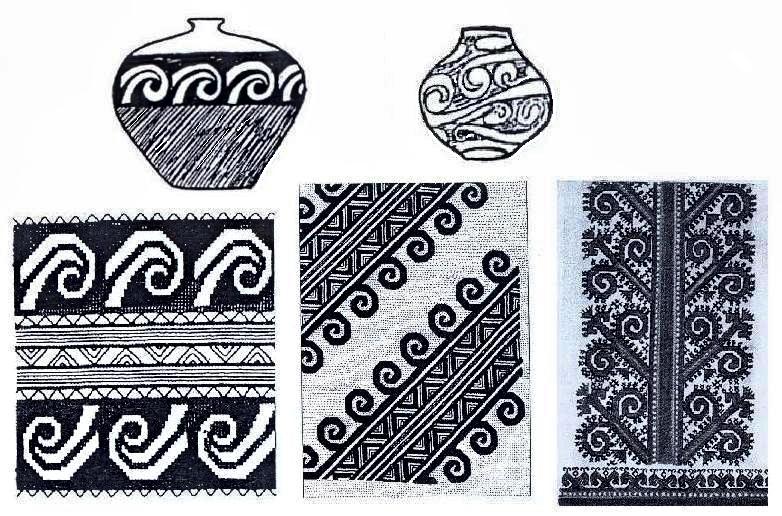
Comparative analysis of the ornament of Trypillians, Chuvash, and Ukrainians shows this Proto-Chuvash role quite clearly. Interestingly, an ornament similar to the Trypollian one was found by archaeologists in China (Banshan Culture, see the section Maykopian Enigma), but Chuvash ornament left unattended, though it samples have been long published (KOROLEVA N.S. 1960, TROFIMOV A.A. 1977, etc).
At right: The figures above show the sample Trypil'ska ceramics in the upper row Bottom left – the modern Ukrainian embroidery, repeating Trypillian ornament (KULCHYTSKA ANNA:1995, 44-45). The rightmost picture – a fragment of the embroidery on the Chuvash women's shirt with a similar motivation (KOROLEVA N.S. 1960, Table 19).
This suggests that it is the creators of culture Trypilla-Cucuteni could develop the image of the Tree of life in the original idea of the universal circulation, where the Sun played the main role with its daily and annual periodicity, visualizing the idea of immortality as the rebirth after death. Grain thrown into the ground dies but gives rise to a new life, obeying the laws of motion of the sun in the sky. That is why the stylized image of the Sun and the Tree of Life can be found on the preserved pottery, but they had to be present in other forms of visual art, which used less durable materials – wood carving, painting, and embroidery on fabrics, articles made of straw, etc.
The image of the Tree of Life was transferred from generation to generation by a population of different ethnic origins who inhabited the steppe and forest-steppe of Ukraine but carried a traditional type of management appropriating local natural conditions. In this way, the Tree of Life was got by Germans, Celts, Slavs, Balts, and other Indo-European peoples. However, all of them, except for the Slavs, perceive the Tree of Life as a more general form of the world tree that could exist in Indo-European mythology since ancient times. Instead, only the Slavs, particularly the Ukrainians, understand the Tree of Life as a triune complex of birth – fertility – death. The image of the Tree of Life is most clearly embodied in the still preserved archaic Christmas customs of Ukrainians to weave by straw and ears so-called "Didukh" (a great-grandfather). Initially, it was just a sheaf of rye or wheat which after a short Christmas ritual involving congratulations for a family was placed by a master in the front corner before the icons (VOROPAY OLEKSA. 1958: 65). Eventually, the sheaf becomes a shape of a tree often using several grains – wheat, rye, barley, oats for plaiting a trunk and branches to give Didukh a more artistic form.
The Tree of Life, together with signs of the sun in the form of flowers is also present in the form of "Berehynia" (Protective Lady) – a homemaker, still revered in the villages of Ukraine.
Left: The Coat of Arms and the flag of Chvash Pepublic
How important the image of the Tree of Life in the worldview of the Chuvash is proved by its presence on the coat of arms and the flag of the Chuvash Republic, adopted on April 29, 1992.
The same significance of the World Tree for the mythology of Ukrainians is confirmed by the fact that its motives are placed among the mosaic of the Virgin Orans-first in Metropolitan of St. Sophia Cathedral in Kyiv, and this leads to the conclusion that here, "Christian iconography is supported by pre-Christian mythological one" (GREY OKSANA. 2003: 229).
Besides the fact of the presence of the Tree of Life in the worldview of Ukrainians and Chuvash, the very form of the tree is noteworthy, ie his presentation with flowing branches. Many samples of Ukrainian embroidery present the Tree of Life very similar to the state symbols of Chuvashia (see figures below).
Right: Patterns of the Tree of Life on Ukrainian embroidery
The figure on the left shows the image of the Ukrainian "Protective Lady" in the form of the Tree of Life where are also the sun sign is present as red flowers. Symbols of the Sun in Ukrainian and Chuvash embroideries are usually depicted as an eight-petal rosette or a flower.
Left: Symbols of the Sun as rosettes of type of kĕskĕ on Ukrainian (upper raw) and Chuvash (low paw) embroideries.
This pattern is called by Chuvash kĕskĕ and it “represents the sun as the giver of life,” wrote the famous expert of the Chuvash language and culture N.I. Ashmarin, according to the words of an old Chuvash (TROFIMOV A.A. 1977: 64). Similar signs on the mirrors and other materials from the burials near Olbia, Scythian Naples, and other places were described by V.S. Drachuk and he suggested that they all represent the Sun (DRACHUK V.S. 1971: 222-229). This observation not only demonstrates a certain cultural continuity but also serves as another argument for the presence of the Proto-Chuvashes in the Northern Pontic region at the Scythian time.
The symbol in the form of a square is present in the ornaments of many cultures. As in Chuvash, and Ukrainian embroideries, it symbolizes perfection, harmony, and order. The square is the opposite of the sign of the sun in the form of a circle, personifying the spirit, while the square personifies substance.
At right: The square in Chuvash (left) and Ukrainian (right) embroideries.
It is very likely that the overall shape of the Chuvash and Ukrainian representation of the "Tree of Life" on created subjects was developed on a real basis and was associated with the image of "Didukh." Heavy ears of Didukh fall down from the tree trunk to its foot and give it a distinctive shape and just such form of the Tree of Life is typical in Ukrainian and, as it turned out, in the Chuvash embroidery. Found in the royal Scythian burial mound Chortomlik silver vase, amphora, which, according to E. Kuzmina, represents a "cosmogram that gives a universal image of the world and above all the idea of eternity and recurrence of life» (BALONOV F.R. 1991: 375). Floral ornament, including "central palmetto on the vertical axis of the vessel is just perceived as the equivalent of the world tree with sitting on its branches birds" (ALEKSEYEV A.Yu., MURZIN V.Yu., ROLLE R. 1991: 122). To some extent, this palmetto with its drooping branches also reminds Ukrainian Didukh (see pictures below), which can confirm the antiquity of the representation of the Tree of Life precisely in this characteristic shape.

Left: Ukrainian Didukh and amphora from Chortomlyk kurgan
Vegetation like palmetto and sun signs in the form of an eight-petal flower are present also on other subjects of Chertomlyk barrow, in particular on a quiver (ibid, catalog 189, item 8, page 234).
Further development of the symbol of the Tree of Life was reflected in one of the elements of heraldry, known as, "Royal (Bourbon) Lily or Fleur-de-lis"
The history of this lily can be traced to the reign of the king of the Franks Clovis (481 / 482-511), but the explanation of its origin is given only legendary (AVELING S.T. 1890: 148-149). The fact that this character originally had, in reality, the meaning of the Tree of Life is told by its shape with flowing branches as well as at Didukh and that it is sometimes supplemented by other plant parts and always is tied up across as a sheaf.
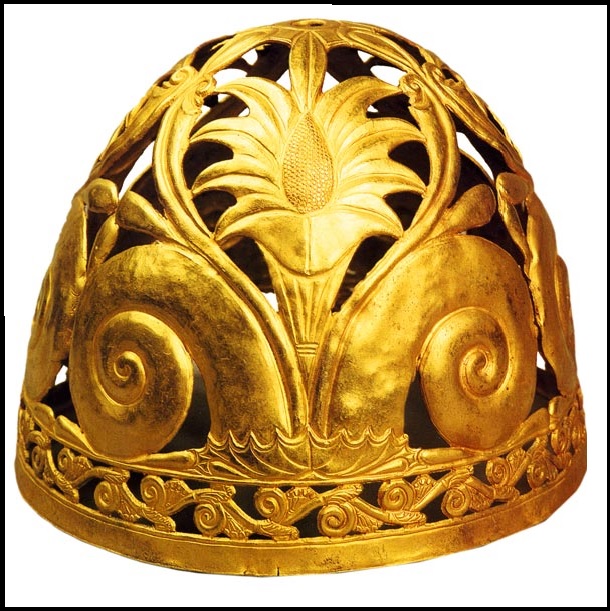
A certain transitional form from the Tree of Life to flower is shown by the Scythian gold helmet found in Aq-Burun mound on the Kerch Peninsula.
At right: Gold Scythian helmet from Aq-Burun mound.
A detail of the central part of the headdress, which probably belonged to some Scythian prince, is more like a flower than a tree or a bundle, but it is characteristic that the "flower" is tied up across at the bottom. Its similarity to heraldic "lilies" can be seen in the illustration below.
 |
Stylized "lily" as an element of heraldry. .
1. Emblem of community Gülzow in Lauenburg district in Schleswig-Holstein, Germany. 2. Emblem of Ukrainian Plast. 3. One version of the Florentine lily. 4. Emblem of Alfdorf in Baden-Württemberg, Germany. 5. Emblem of Burzemkand, a historic and ethnographic area in southeastern Transylvania, Romania.
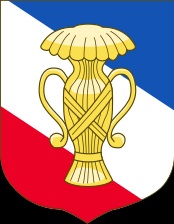 |
Using lilies as a heraldic element had no ideological meaning, while the sheaf symbolized wealth and prosperity. That a sheaf has been long since used as a heraldic symbol, is said by its presence in the coat of arms of the Swedish House Vasa (see. Fig. right). But its original shape was the same as Ukrainian Didukh but later it has become a more aesthetic shape, which gave a new explanation of this symbol.
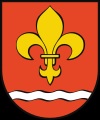
Another confirmation of the development of the heraldic element in the form of a lily from a stylized sheaf is the coat of arms of the German city of Roggetin in the land of Mecklenburg-Western Pomerania. The central place in the coat of arms is the so-called lily (see left), which should characterize the agricultural activities of the former residents of the city since Ger. Roggen "rye" is present in its name. Obviously, in the old times, when Roggetin was still a village, it became famous for good rye harvests and this was the reason for choosing a sheaf of rye as a coat of arms, which in accordance with tradition took the form of a lily in time.
Also another element of heraldry in the form of the Latin letter W, which is present on the knight's coat of arms of Abdank of numerous Ukrainian and Polish clans (see the image of the coat of arms on the lower left), can also have Trypillian roots because it was found on Trypillian clayware (on the photo lower right). However, this element can be more widely disseminated among different people, in which it is in this form a symbol of water, as well as a symbol of the sign of Aquarius.

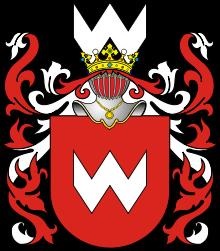 |
As Chuvash and Ukrainians decorated with embroidery many household items – towels, napkins, curtains, but especially rich embroidery is present on various items of clothing Chuvash and Ukrainian national costumes. Thus except for the similarity of used characters, you can see the same location on the details of embroidery of folk costume – on the neck of a shirt, its brisket, sleeve cuffs, hem, ie in places that give access to the human body. People try in such a way to protect themselves from unwanted influences of the environment (SAVCHUK BORYS. 2004: 388). It should also be noted that more commonality with Chuvash folk clothing can be found in western Ukrainians, ie the inhabitants of the territory, where the Proto-Chuvashes lived once. For example, the experts noted that the Tree of Life decorated sleeves of women's clothing on the Podolia, Bukovina, and Pokuttia (PAVLUK S.V., Ed. 2006)
Ukrainian (left) and Chuvash (right) women in folk clothing.
Rich embroidery is especially characteristic of Ukrainian and Chuvash towels, which have not only domestic but also ritual significance:
along with the major components – bread and salt – towels are also endowed with certain magical actions aimed at augmentation of wealth, a happy life, etc. (NIKORAK OLENA, 2001: 507)
The custom of offering "bread and salt" for guests of honor on the richly embroidered towel is widespread among Slavs and Chuvash. One might think that it is an ancient Chuvash custom borrowed by Slavs as Chuvash expression çăkăr-tăvar "bread and salt" because of its rhyming should be considered as primary concerning the Slavic. The fact that the ancient Proto-Chuvashes extracted and traded salt is considered in other sections of this work.
Speaking about Ukrainian and Chuvash embroidery we can not ignore the folk costumes, closely associated with embroidery. Experts understand how national costume reflects the national identity of the people:
Traditional costume, its origin, and evolution, the formation of local and national characteristics, and practical experience emphasize the specifics of a particular ethnic group and are an important historical source that reflects the material, spiritual and artistic spheres of the culture of the people (NIKOLAYEVA TAMARA, 2005: 11).
However, local features of folk costumes can be so expressive that they help to determine the residential land of people wearing a certain type of clothing, so finding common elements in national costumes is very difficult. In addition because unlike symbols, the shape, and cut of the garment are very dependent on external influences, not only in terms of adaptation to new environmental conditions, but also on the overall progress in the design of clothing and, of course, from fashion. Besides, experts, describing folk costumes, try to show them in all their diversity, do not distinguish common features with clothes of neighboring peoples clothes, and do not indicate likeness. An example of such a relationship can be a very interesting book "Peasant clothing of population of European Russia" (BELITSER V.N. 1971, 290-310).
It is more promising to look for the community, not in underwear garment that is most accessible to changing but in fine details. And then we can find a community between the Chuvash and Ukrainians wearing a wide belt of dense fabric with woven patterns and fringe on the ends (see pictures below)
Woven men's Belts (Chuvash left, right – Ukrainian).
Chuvash men have headdresses approximately the same as that of their ancestors Scythians – in the form of an elongated cone. There is evidence that Hutsuls wore hats of the same form still quite recently. This fact was recorded in Hutsulia repeatedly – in the description of Balthazar Gacket (German ethnographer who has devoted many years to studying life and living conditions of the Hutsul in the XVIII century. – V.S.), by I. Vahylevych (40- of the XIX cent.), and in a sketch of artist Yu. Glogowski (early XIX century.) It is believed that the tailoring of the conical hat is old and resembles by shape woven in XI cent. hoods and one gives it such an explanation:
It is a lot easier ta carve out and sew a conical hat than a hat made of sheepskin with a spherical top, for which a corresponding wooden shape is required. Therefore, we can say that copied by Yu. Glogowski Huzulian cap is differed by archaic features (KRVAVYCH D.P., STELMASHCHUK G.G. 1988: 222)
A Hutsul of 19 cen. and a modern-day Chuvash in similar hoods
It is noteworthy that the Chuvash folk costume is different from the Ukrainian one not more than the costumes of ethnic groups of Ukrainians are different. Having a certain similarity with the Ukrainian, it differs greatly from the samples of their clothes close neighbors – Tatar, Mari, and Mordovians-Erzya. Women's clothing of southern neighbors of Chuvash Mordovians Erzya and Moksha has a more modest embroidery, but a lot of jewelry and using for decoration colored ribbons, which is absent in the Chuvash costume. Chuvash national costume is totally different also of Russian and Tatar ones but has a vague resemblance to Mari, which may be explained by mutual cultural influences of neighboring nations, which can be traced also in music.
If we compare the Ukrainian national costume, it has, of course, similarity to the costumes of other Slavic people, but has nothing to do with non-Slavic people's costumes except Chuvash. The last is important for us, among other things, for solving the ethnicity of Scythians. The widespread opinion that the Ossetians as their descendants finds no confirmation when comparing Ossetian national costumes with the Chuvash and Ukrainian ones. This is a completely different style and different technique, not having anything to do with the Chuvash nor Ukrainian samples. If Ossetians were descendants of the Scythians, then some similarity between Ukrainian embroidery and Ossetian would have to take place.
Comparing Folk Dress of Some East European Peoples
Besides artistic embroidery woodcarving is very common among the Chuvash, as they are close to the Carpathian Ukrainians and archaeological finds indicate that carpentry and joinery were at a very high level in Volga Chuvashes. Wooden Churches of the Carpathians, decorated with rich carvings, also were built with great skill and related to historical and cultural monuments of Ukraine. Woodcarving is usually presents a traditional national pattern, so searching for similar motifs in the Chuvash and Carpathian ornaments could enrich our knowledge of the Proto-Chuvash roots in the folk culture of the Ukrainians. While it is possible to say that the Chuvash and Hutsuls widely practiced quite similar cruciform square patterns of ornament. (ARKHANDEL'SKIY D.I. 1925, KURYLYCH MYKHAYLO. 2001).
Similar motifs in the literal and figurative sense of the word can be searched also in Ukrainian and Chuvash folk music, particularly in the possible similarity of the Ukrainian "kolomiyka" and Chuvash folk songs. (See Section Traces of Cultural Relations of Peoples of Eastern Europe in Music)
Proto-Chuvah traces can also be found in folk Ukrainian cooking. The first striking is that similar words for any first course are used by Ukrainians and Chuvash: (Ukr. yushka, Chuv. yashka). The name of ancient Ukrainian dishes from beets, pickles, horseradish, and onion taratuta is very well translated using the Chuvash language: Chuv. tără 1. "top", 2. "clean" and tută "taste", what can be understood as "tasteful". Thanks to this explanation we can learn about the tastes of ancient Ukrainians and estimate the time of spreading some edible plants, not previously endemic to the territory of Ukraine. By the way, Ukr. khrіn, Rus. khren "horseradish" also have Prto-Chuvashsh origin (Chuv. khĕren). Jelly made of flour and called jur is prepared till now in Carpathian villages that is where the Proto-Chuvashes left most of their traces. We can assume that this name should be associated with Chuv. yur "to knead, make sour". If Cossack scherba "fish soup" was not borrowed from the Tatars, then from the Proto-Chuvashes. Many Turkic languages have the word shurpa/chorba for the names of different soups, but Chuv. shürpe is most suitable phonetically. The Proto-Chuvashsh origin of another Cossack dish solomakha is less plausible. Chuv. sulămlăkh "power, vigor" phonetically fits well, but was the solomakha so nourishing to have such fame? M. Vasmer opposed the Slavic origin of pirog "pie" from Chuv. pürĕk, but perhaps he was wrong. The Chuvash word comes from pürĕ "kidney", which can be seen also in Chuv. püremech "cheesecake". The last word is common among many peoples of the Volga country in the form peremyach and Udmurt – perepech "a little pie". We can assume that Ukrainian perepіchka "a flat cake" has also to be attributed here. Among drinks, only Slavic braga "homemade beer" has Proto-Chuvashsh origin. This time Fasmer did not oppose the connection of the Slavic word with Chuv. pεraGa "pomace, residue".
In general, we can say that a certain influence of the Proto-Chuvash cultural substrate was more detected in material signs of Ukrainian folk culture. Differences in the spiritual cultures of both peoples, forming in earlier times, hindered the interpenetration of mythology and alien gods in the established traditional pantheon. This opinion should be out of correspondence Ukr. babay "terrible grandfather" who frightens small children, Chuv. papay meaning only "grandfather" now. However, the Scythians, the ancestors of the Chuvash, had a chief deity, according to Herodotus, called Papay, whom they revered as a mythical ancestor. The ancestors of the Ukrainians knew the strange god but did not take him and obviously feared giving him terrible traits.



